Intel Pentium 4 6xx and 3.73EE: Favoring Features Over Performance
by Anand Lal Shimpi & Derek Wilson on February 21, 2005 6:15 AM EST- Posted in
- CPUs
The Test
Our hardware configurations are similar to what we've used in previous comparisons.
AMD Athlon 64 Configuration
Socket-939 Athlon 64 CPUs
2 x 512MB OCZ PC3200 EL Dual Channel DIMMs 2-2-2-10
NVIDIA nForce4 Reference Motherboard
ATI Radeon X800 XT PCI Express
Intel Pentium 4 Configuration
LGA-775 Intel Pentium 4 and Extreme Edition CPUs
2 x 512MB Crucial DDR-II 533 Dual Channel DIMMs 3-3-3-12
Intel 925XE Motherboard
ATI Radeon X800 XT PCI Express
Business/General Use Performance
Business Winstone 2004
Business Winstone 2004 tests the following applications in various usage scenarios:
. Microsoft Access 2002
. Microsoft Excel 2002
. Microsoft FrontPage 2002
. Microsoft Outlook 2002
. Microsoft PowerPoint 2002
. Microsoft Project 2002
. Microsoft Word 2002
. Norton AntiVirus Professional Edition 2003
. WinZip 8.1
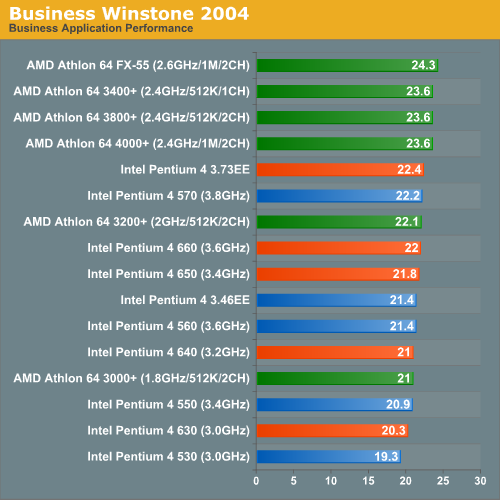
Office Productivity SYSMark 2004
SYSMark's Office Productivity suite consists of three tests, the first of which is the Communication test. The Communication test consists of the following:
"The user receives an email in Outlook 2002 that contains a collection of documents in a zip file. The user reviews his email and updates his calendar while VirusScan 7.0 scans the system. The corporate web site is viewed in Internet Explorer 6.0. Finally, Internet Explorer is used to look at samples of the web pages and documents created during the scenario."

The next test is Document Creation performance, which shows very little difference in drive performance between the contenders:
"The user edits the document using Word 2002. He transcribes an audio file into a document using Dragon NaturallySpeaking 6. Once the document has all the necessary pieces in place, the user changes it into a portable format for easy and secure distribution using Acrobat 5.0.5. The user creates a marketing presentation in PowerPoint 2002 and adds elements to a slide show template."

The final test in our Office Productivity suite is Data Analysis, which BAPCo describes as:
"The user opens a database using Access 2002 and runs some queries. A collection of documents are archived using WinZip 8.1. The queries' results are imported into a spreadsheet using Excel 2002 and are used to generate graphical charts."
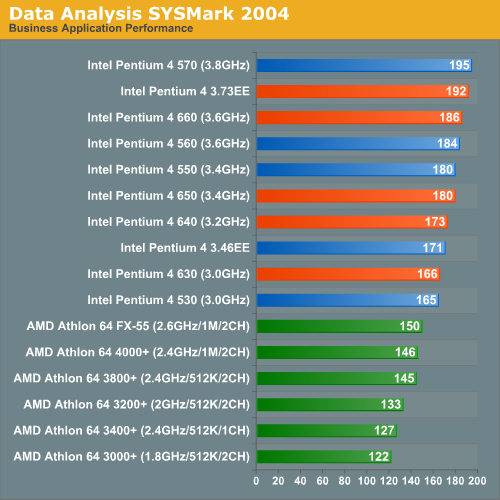
Microsoft Office XP SP-2
Here we see in that the purest of office application tests, performance doesn't vary all too much.
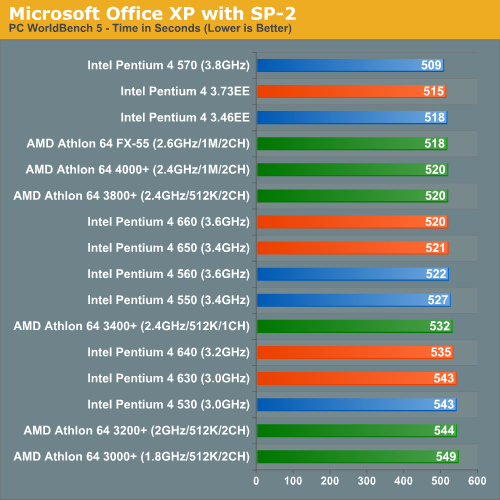
Mozilla 1.4
Quite possibly the most frequently used application on any desktop is the one we pay the least amount of attention to when it comes to performance. While a bit older than the core that is now used in Firefox, performance in Mozilla is worth looking at as many users are switching from IE to a much more capable browser on the PC - Firefox.
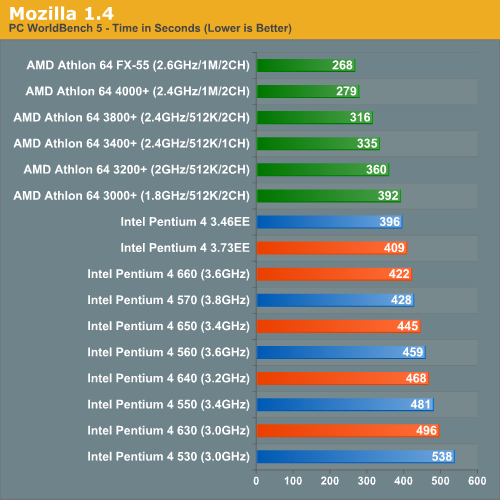
ACD Systems ACDSee PowerPack 5.0
ACDSee is a popular image editing tool that is great for basic image editing options such as batch resizing, rotating, cropping and other such features that are too elementary to justify purchasing something as powerful as Photoshop for. There are no extremely complex filters here, just pure batch image processing.
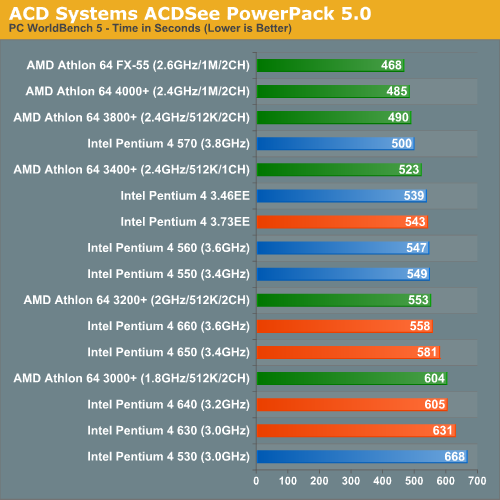
Ahead Software Nero Express 6.0.0.3
While it was a major issue in the past, these days buffer underrun errors while burning a CD or DVD are few and far between thanks to high performance CPUs as well as vastly improved optical drives. When you take the optical drive out of the equation, how do these CPU's stack up with burning performance?
As you'd guess, they're all pretty much the same, with the slight variations between chips falling within expectations. Any of these chips will do just fine.
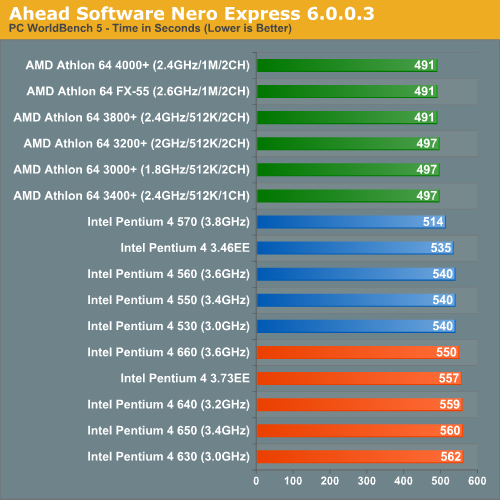
Winzip
Archiving performance ends up being fairly CPU bound as well as I/O limited.

WinRAR 3.40
Pulling the hard disk out of the equation we can get a much better idea of which processors are truly best suited for file compression.











71 Comments
View All Comments
johnsonx - Monday, February 21, 2005 - link
Is there no merit at all in running a few A64 vs P4 6xx benchmarks with the current RC build of XP x64? While I've found too many things I need don't work with XP x64 to use it, I did see that 3dMark03 ran fine. I know 3dMark itself isn't 64-bit, bit it does making heavy use of 64-bit DirectX and graphic driver calls. There must be a few more apps and games that could be called on...Maybe just limit the benchies to two processors, say an A64 3500+ vs. a Pentium 4 650, running the same benchmarks in 32-bit and 64-bit Windows, using just one GeForce 6xxx and one Radeon X8-something.
It'd just be interesting and useful to see which processor runs 64-bit code better, both absolutely and compared to each processor's 32-bit performance.
When the final release version of XP x64 does come out, it may be interesting to have benchmarks from the RC version to see what's improved (though I agree it wouldn't actually be useful in any practical sense).
Or perhaps Anandtech knows something I don't, like the release XP x64 is so close that running benches on the RC would be moot....
SLIM - Monday, February 21, 2005 - link
#30 and 36Hans is right, the 3000 and 3200 cores in the graphs are not available in retail (downclocked 130nm cores) and are meant to show power consumption scaling with speed increases. It's unfortunate that they left out the more interesting comparison (the 130nm 3500+). The only 90nm AMD chip in the power graphs is the 3500+.
coldpower27 - Monday, February 21, 2005 - link
Very strange your the only guys so far that show an increase in power consumption of the P4 6xx Series over the 5xx Series.Regs - Monday, February 21, 2005 - link
Wow, a lot of good comments here. mlittl3, most of the Anandtech's population know that the EE's are just overpriced Northwood's on steroids (Big heads, small balls). And the crayon wax melting comparison made me laugh out loud.I just find it funny Intel is trying to slap on everything but the kitchen sink on these processors to make them more appealing. What's next? Are they going to come with a microwave toaster oven combo? With all do respect to Intel, to add on such features is not an easy thing to do at a engineering level but once again I feel that their marketing team is still running the show.
But what is AMD doing while Intel performs CPR on their Prescott's? All this news on Intel for the past few months left me nostalgic in what AMD is doing behind the scenes. SSE3 was their latest slap-on feature, but as we saw in your recent AMD article it offered little to no performance gain. AMD's next core has to offer lower L1-l2 Cache latencies. This is the only way I see AMD cornering Intel's Cores performance in every application. But im afraid we won't see any such thing until long-horn comes out in a few years. Until now we have to settle for worthless add-ons features for the desk-top consumers while we see both Intel and AMD battle the server market where Intel is mostly threatened.
HardwareD00d - Monday, February 21, 2005 - link
In Soviet Russia, Prescott melts YOU!miketheidiot - Monday, February 21, 2005 - link
why do the 3000 and 3200 have signifigantly higher power consumption than the 3500? I thought all 3200 and 3000 are also built on 90nm soi.RadeonGuy - Monday, February 21, 2005 - link
Even With All the processors haveing 2mb cache they still suck assHans Maulwurf - Monday, February 21, 2005 - link
#30 I think the 3000 and 3200 are not really Winchester cores. Maybe clocked down 130 nm cores.I´m interested in the memory timing of the A64. Is it 1T or 2T? This is an important information, you should always(!) give it the configuration part of reviews.
DerekWilson - Monday, February 21, 2005 - link
One thing to remember about out power tests --We measure power draw at the wall. Power supplies are inefficient and magnify power draw at the wall. Power input to the PSU does not scale proportionally to power output.
Brian23 - Monday, February 21, 2005 - link
I thought that all winchesters were 90nm SOI.